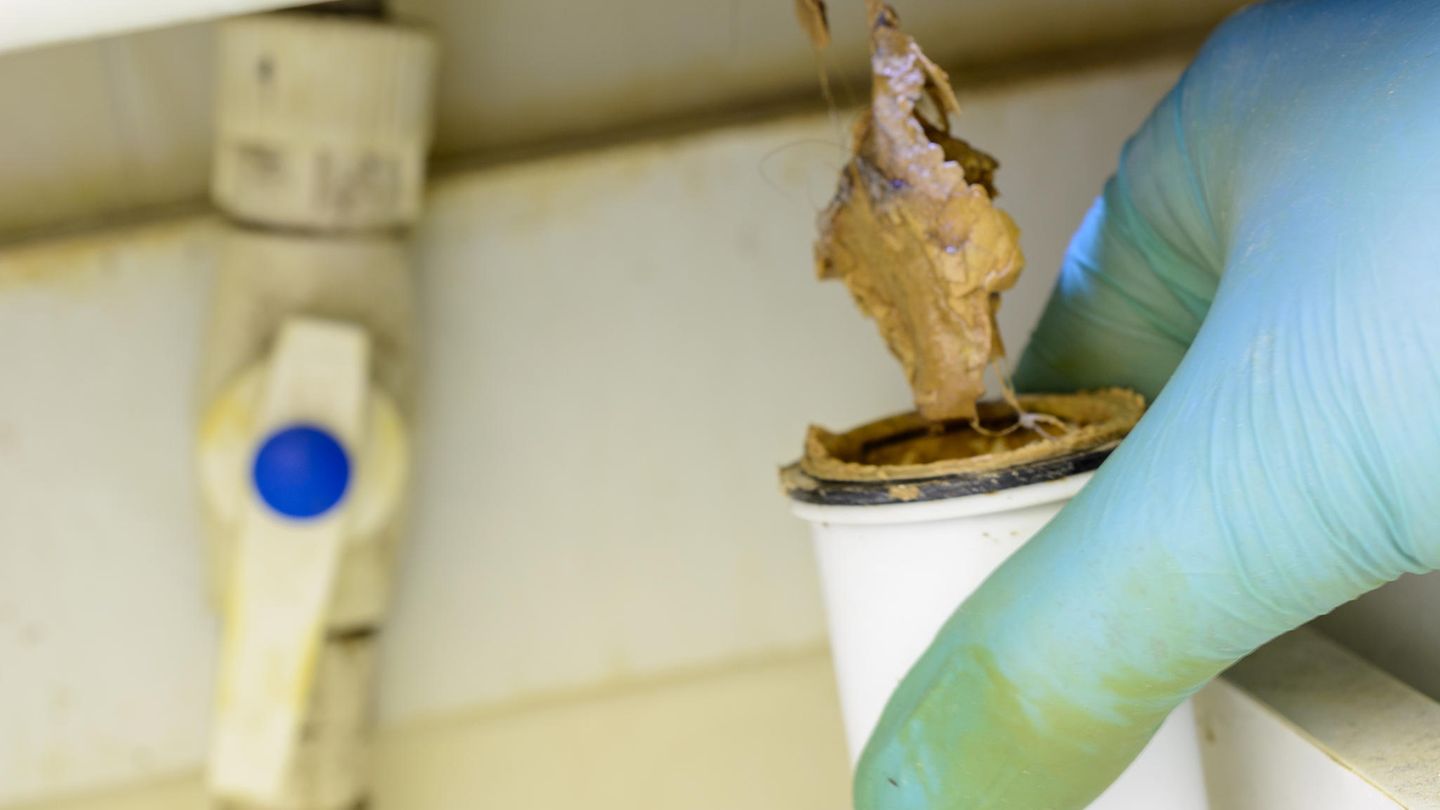The water no longer drains properly and remains in the basin for minutes, even if the stopper has been pulled. Then it’s time to clean out the drain.
Blockages can be cleared mechanically – or with a chemical attack. Remedies like Drain Free can loosen blockages and deposits. How good the result will be depends primarily on the type of constipation. Fat and goo residues are reliably dissolved, but if a needle or a match is to blame for the jam, the remedies have no effect. Frequent use of the chemical club also attacks the material of the drain.
Even if you have an aversion to the chemical club in the household: The inexperienced should first try a pipe cleaner before reaching for the pipe wrench.
Caution caustic
If you are taking chemicals, you need to study the instructions. Rubber gloves, a smock and eye protection are important, the agents are corrosive and even small splashes discolor clothing.
This is how it works: Assuming that the water in your basin hardly runs off. Then wait a long time until you are sure that the water has dripped away. Then fill up the pipe cleaner – possibly with a little water – until the backwater can be seen in the drain. Problem with this: You can only get blockages in the actual drain, if the problem is in the pipes behind it, you have to dismantle the drain.
After that, you have to let the agent take effect. Take your time, then rinse and then repeat the procedure. You shouldn’t use hot water, it can intensify the reaction. Above all, you should not add any other cleaning agents such as toilet cleaners, the wrong mix can produce toxic gases. Pipe cleaners are also available as granules. If it comes into contact with water, it creates gases and heat. Overdosing can cause plastic to melt.
Objects do not dissolve
This is the simplest method, but it does not help with mechanical causes – coins, ear sticks, etc. The agents also bite their teeth on some dirt. In such a case, you will have to dismantle the drain if it is accessible. This is usually a foul smelling and disgusting business. You will need a bowl for sewage, gloves and old rags. The only tools you need are a screwdriver with a slot and a pipe or fitting pliers. Never start this work on a Sunday, it is important that you can go to a hardware store in a pinch.
The drain is located below the wash basin or sink. You have to clear everything there, but it can still be tight. Before you dismantle anything, take a few photos of the assembled process so that you can reassemble it correctly. If the basin has an old-fashioned rubber plug, it is usually sufficient to remove the lower “U” of the drain. If you have a modern lever-operated closure, you have to remove the entire drain, as dirt and hair tend to collect around the lifting mechanism of the fancier closure.
If meticulous cleanliness is important to you, the entire drain must be removed anyway. With a little luck you can loosen the wide rings of the clasp with your hand and a cloth, otherwise you will have to use pliers. Working with a pipe wrench quickly leaves traces on shiny chrome drains, so put something under the jaws of the pliers. The screw connections can get very tight. So tight that old metal drains will tear rather than give way. But when that happens, the drain is already used up and needs to be replaced. You loosen the lower knee, the screw connection of the locking mechanism and finally the long screw that holds the drain in the basin.
Now at the latest you will notice why the drain is also called an odor trap, the standing water in the “U” keeps odors out of the sewer system, which now penetrate the apartment. The opening of the drain must now be closed with a wet rag.
Concentration when assembling
From the outside, the drain looked clean and shiny – inside it should be black and greasy. All components must be rinsed with warm water. Remember to remove hair from the lifting mechanism. If you continue to disassemble the drain, be sure to take more photos as well. In particular, the seals must be placed in the original location. Do not confuse the conical compression seals with the flat sealing rings. Once cleaned, the drain is installed exactly as you dismantled it.
If you have to work lying upside down, it is not very enjoyable. Even so, you need to work very carefully, otherwise the drain will drip.
If you want to replace the old drain, you will probably have to shorten the drain pipe – for this you will need a saw that cuts the material (plastic or metal).
Shower and bath
Drains in the shower and bath that you cannot reach are difficult. Here you have no choice but to remove the hair remnants with pliers and trust the chemistry. Devices are reported on the Internet that promise to release any blockage with pressure. There are usually impressive videos that show how a lump is pressed out of a transparent pipe system. That usually doesn’t work in practice. Why? Because you don’t have a closed system filled with water at home. The pressure escapes where there is the least resistance. That is the overflow of the basin, or the second basin or some pipe that is connected before the blockage. Furthermore, there must be no air in the pipe system, it is compressed and cushions the pressure surge.
Jam in the pipe
If the jam is not in the drain but in the pipes behind it, good advice is expensive. Then it is actually time to call a specialist company. Alternatively, you can attach a pipe cleaning spiral to the pipe behind the drain or try your luck with chemicals, then the pipe cleaner should be poured directly into the drain pipe and not through the sieve on the basin. In both cases, the drain must first be dismantled.
Much larger debris can collect in a long drain pipe than in the system below the basin. So you need patience and a lot of pipe cleaner. In the bathroom, the drainpipes of the washbasin, bathtub and shower usually clog when a foreign object has gotten into them. In the kitchen, the mixture of heavy dirt – such as coffee residues from the espresso machine – and too little gradient can lead to deposits that you can stir up with the spiral.
How far you go with the spiral depends largely on the strength of the turns of your drainpipes. Even if the gray drainpipes are freely accessible in your apartment, for example in the basement under the kitchen and bathroom, a layperson should keep their hands off them. They are often very difficult to dismantle. Toilet pipes have a larger diameter. They actually only clog because a foreign object such as a children’s toy has been sunk into them. Chemistry is useless here, a specialist company has to work because the toilet has to be dismantled,
Conclusion
Dry cleaning should be sufficient for clogging with organic matter if you proceed with caution. It is crucial that the active ingredient reaches the site of the constipation and that you have enough patience. Remember: these chemicals are dangerous and really should be kept out of the reach of children.
David William is a talented author who has made a name for himself in the world of writing. He is a professional author who writes on a wide range of topics, from general interest to opinion news. David is currently working as a writer at 24 hours worlds where he brings his unique perspective and in-depth research to his articles, making them both informative and engaging.




